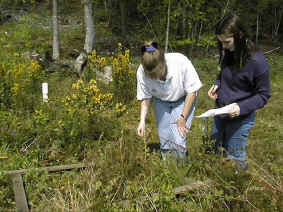
ECOLOGICAL SAMPLING METHODS
Contents
Which Method to Use?

| Stratified Sampling? | |
| Stratified sampling is simply the process of identifying areas within an overall habitat, which may be very different from each other and which need to be sampled separately. Each individual area separately sampled within the overall habitat is then called a stratum. The habitat may be fairly uniform, in which case, this is unnecessary. More here | |
| Random Sampling? | Systematic Sampling (Transects)? |
|
|
| Comparison of results obtained using random & belt transect methods |
|
| Systematic Sampling - Line or Belt? | |
| Line Transect? | Belt Transect? |
|
|
What interval should be used? Transects can either be continuous with the whole length of the line being sampled, or samples can be taken at particular points along the line. For example, every metre, or every other metre. For both line and belt transects, the interval at which samples are taken will depend on the individual habitat, as well as on the time and effort which can be allocated to the survey.
The ideal interval will be chosen by balancing the complexity of the individual habitat with the purpose of the survey and the resources available to carry it out. |
|
Ecological Sampling
Contents